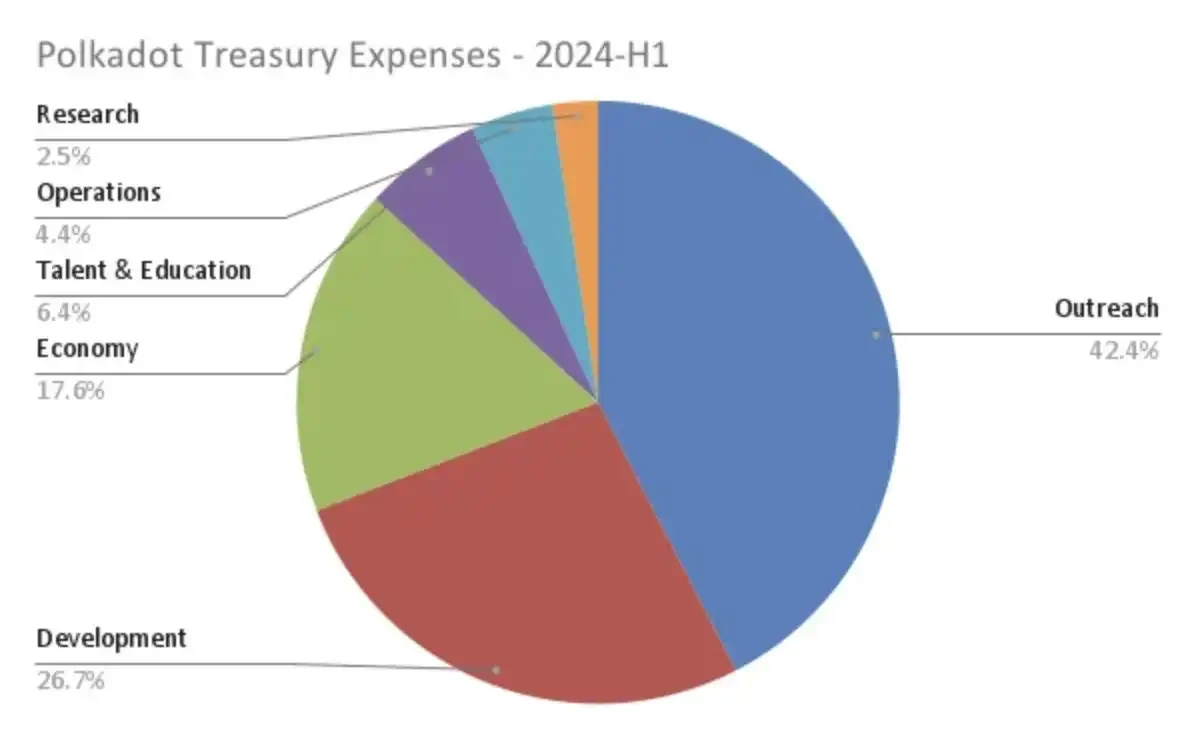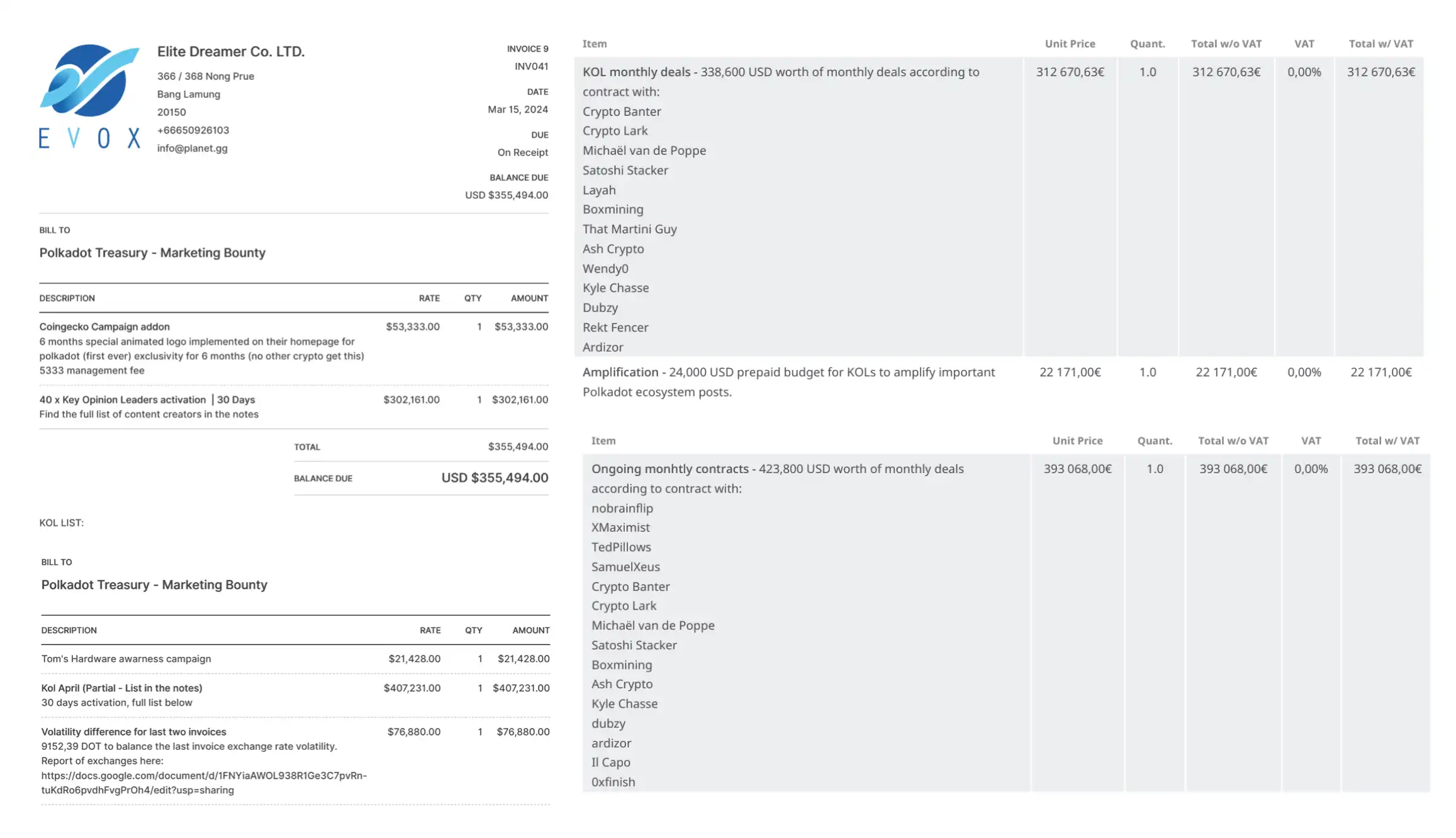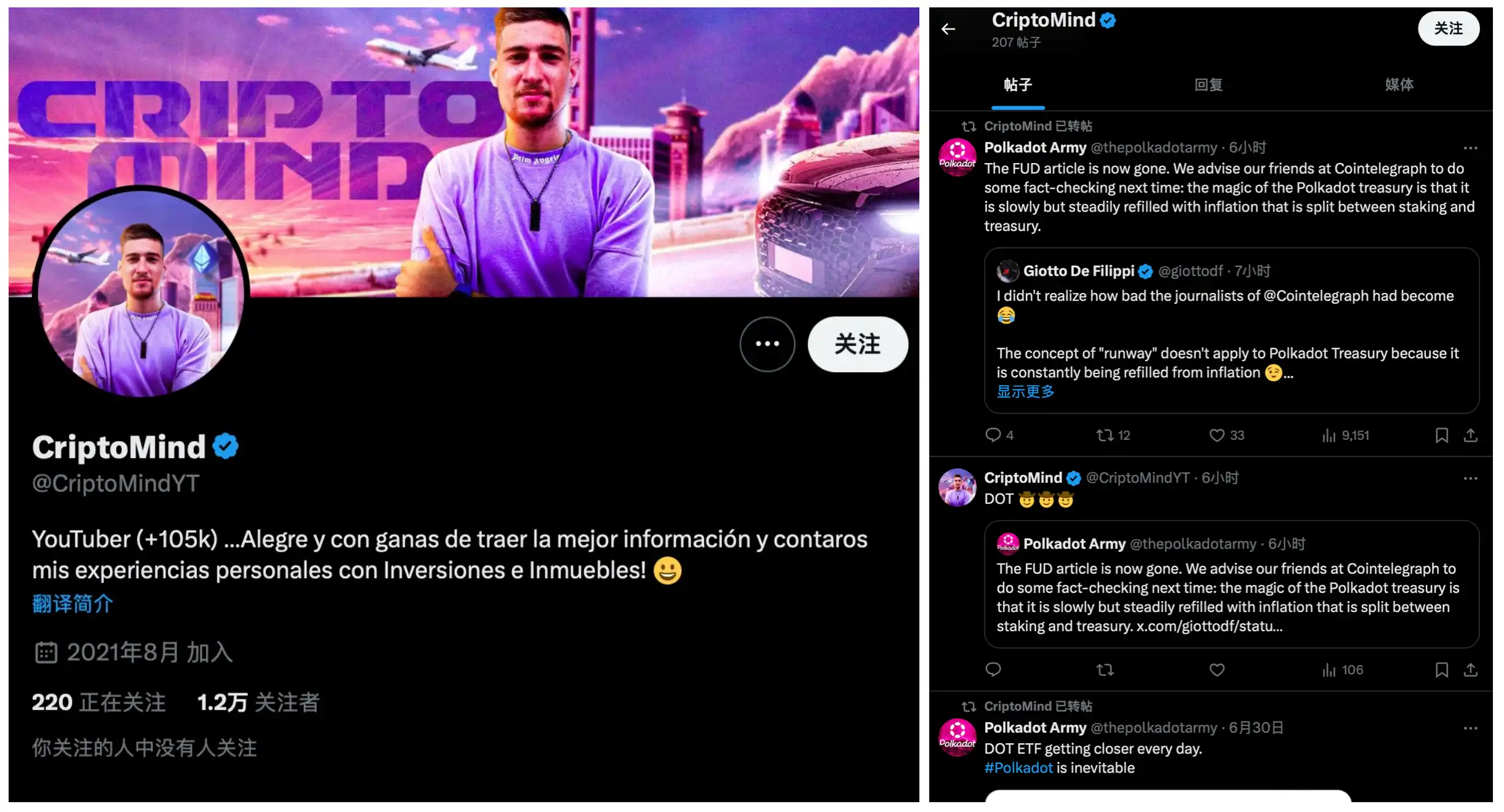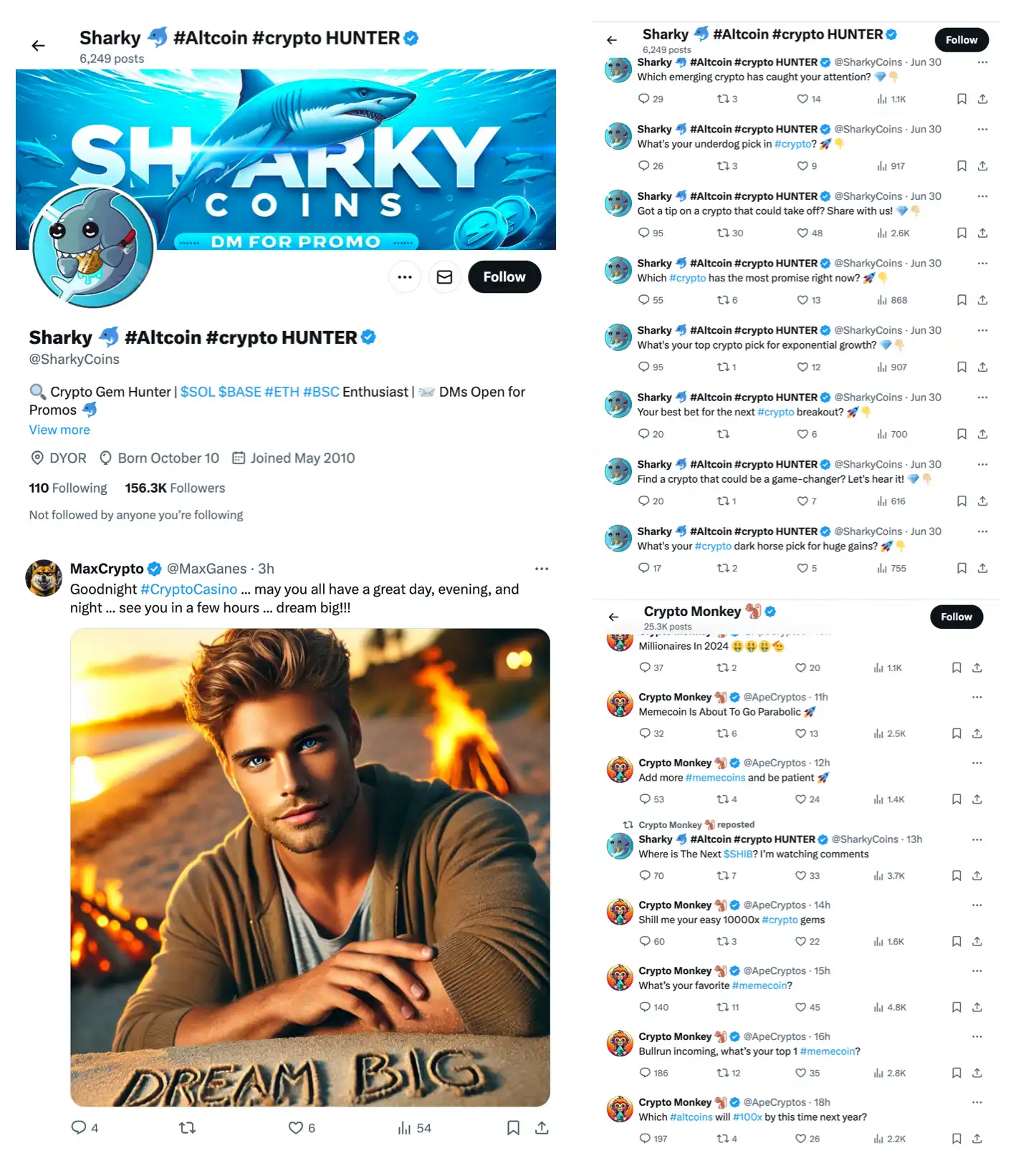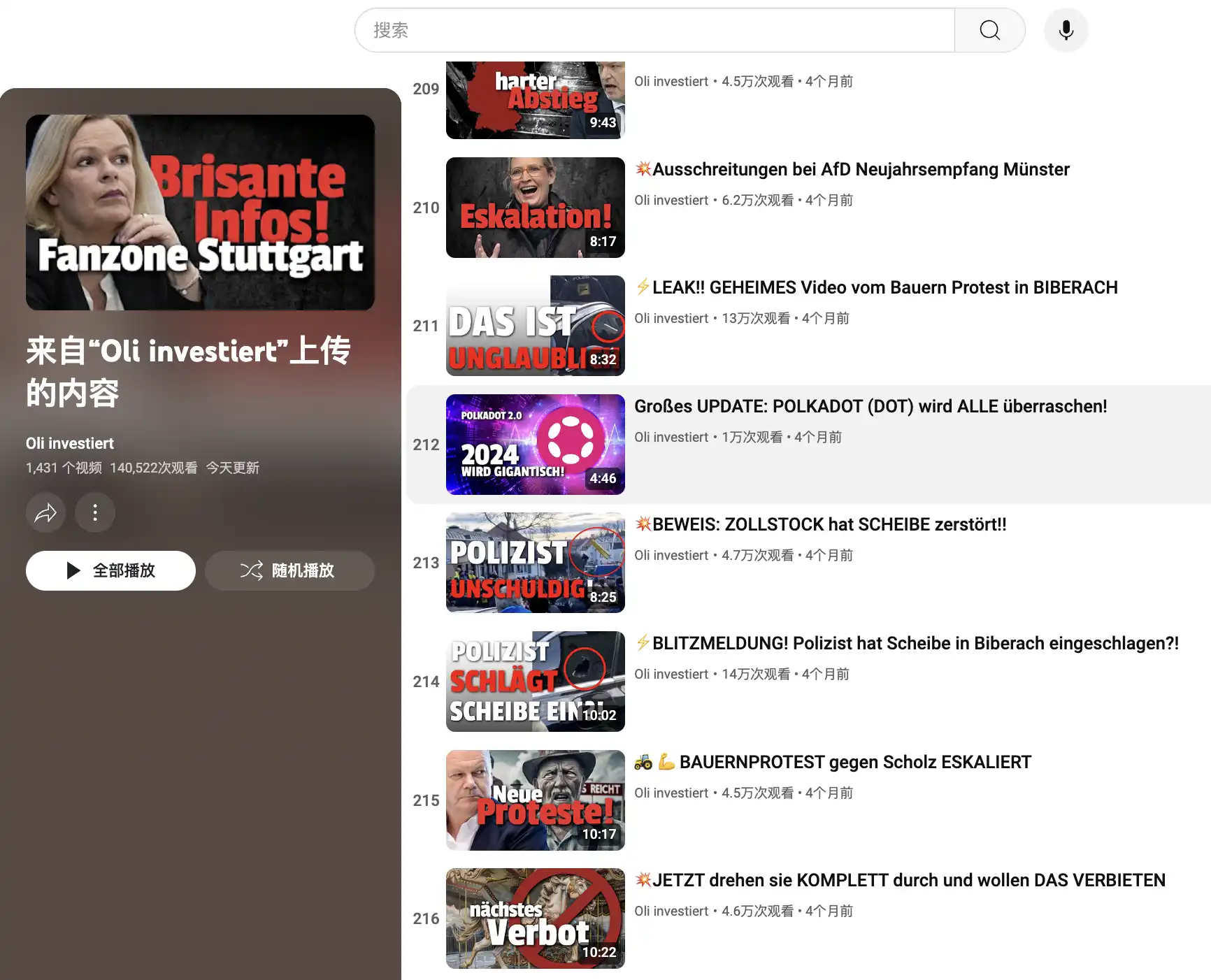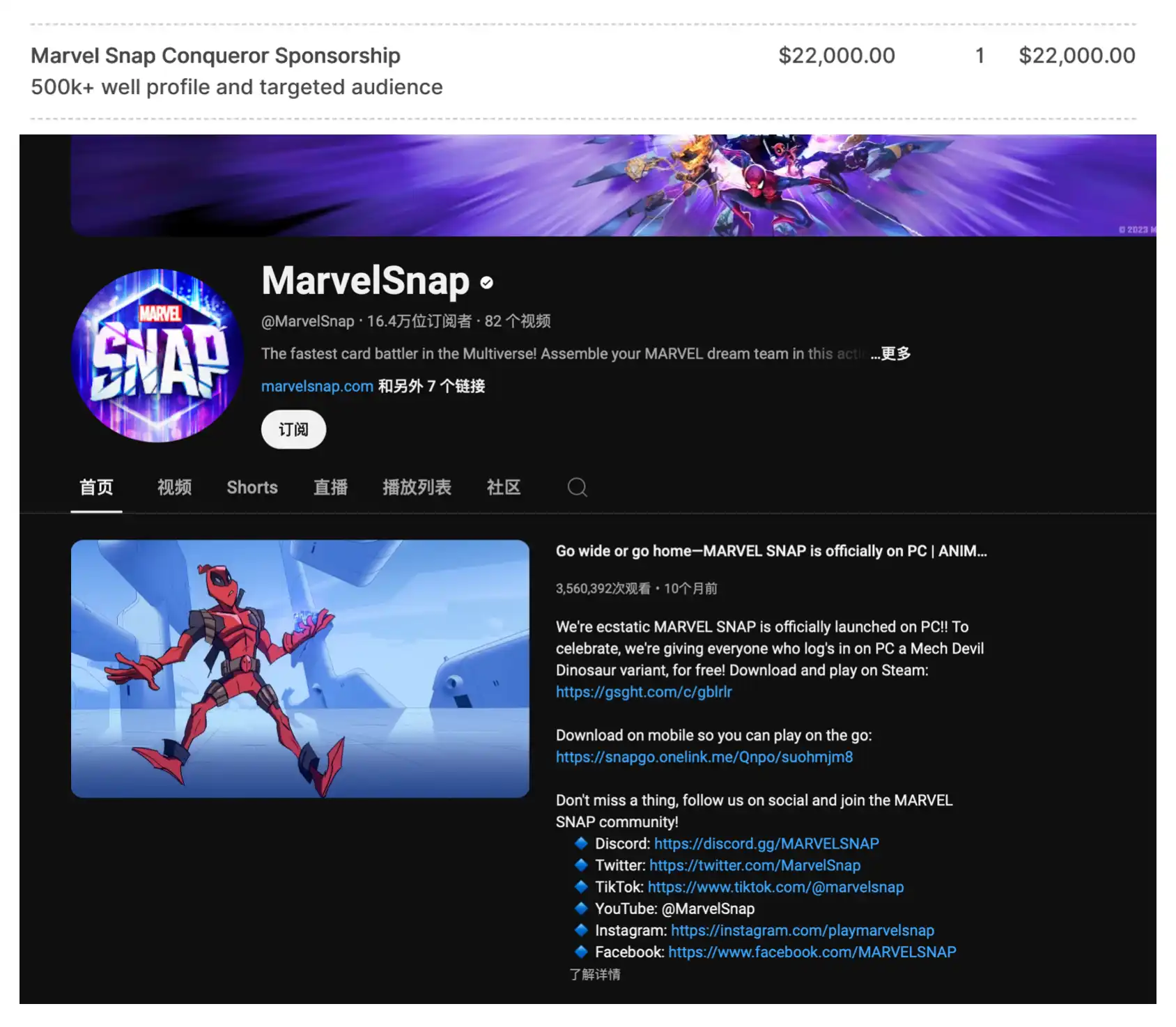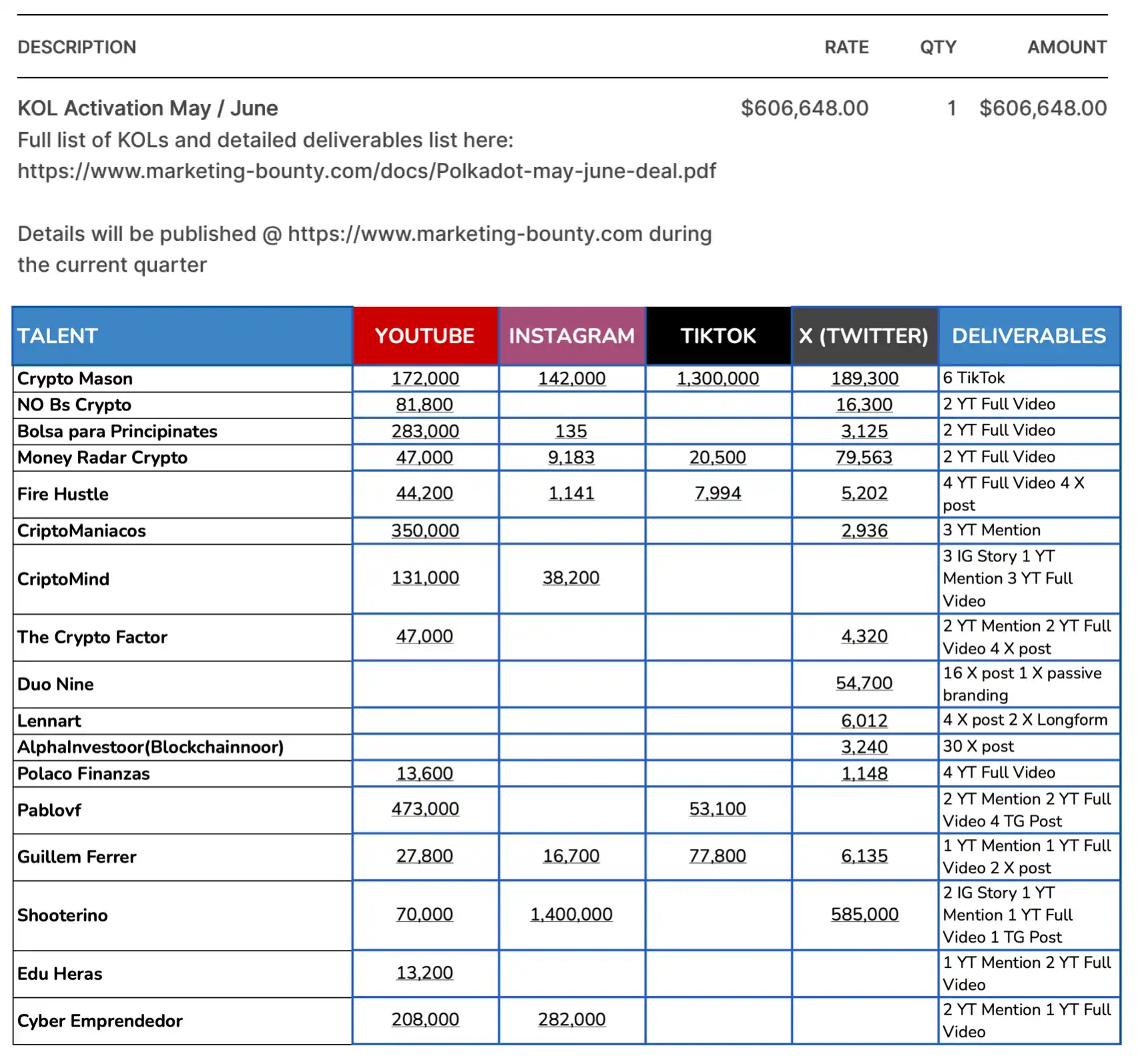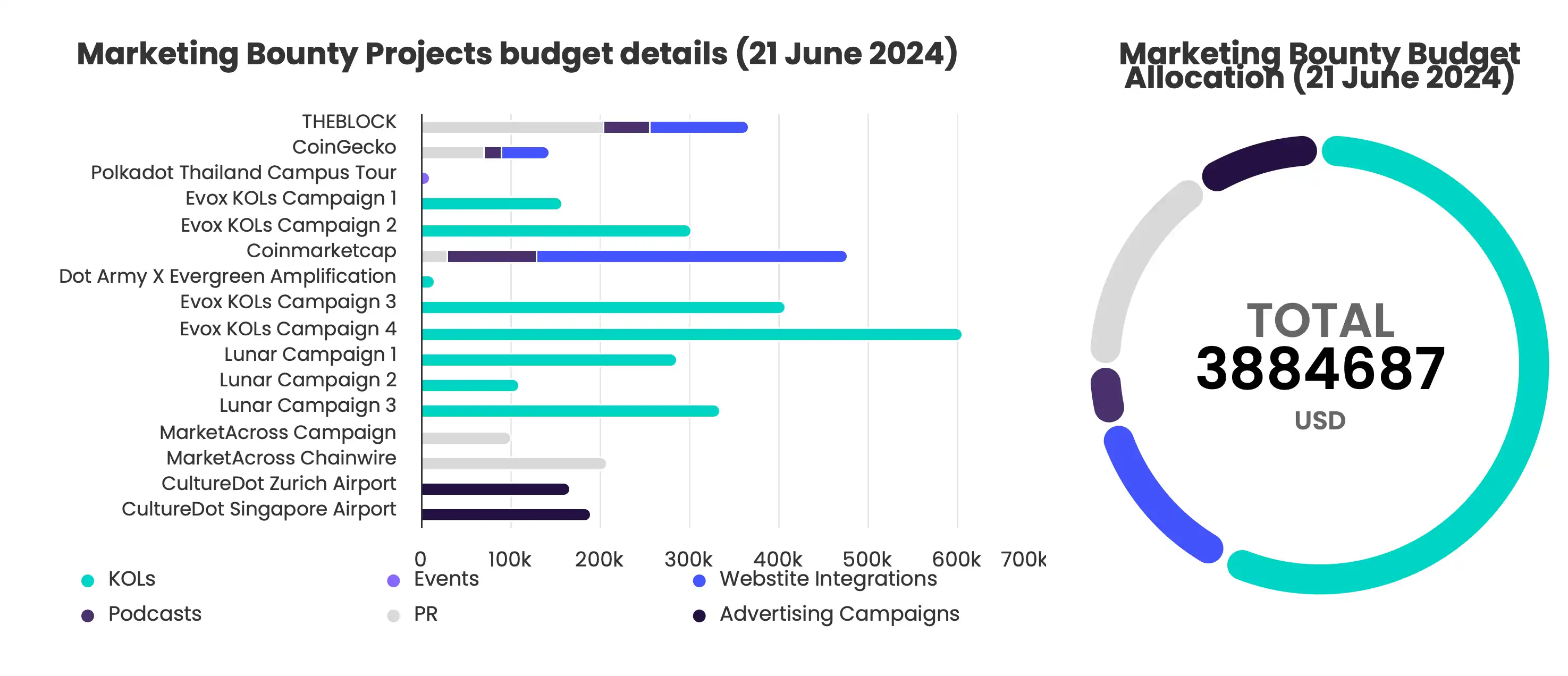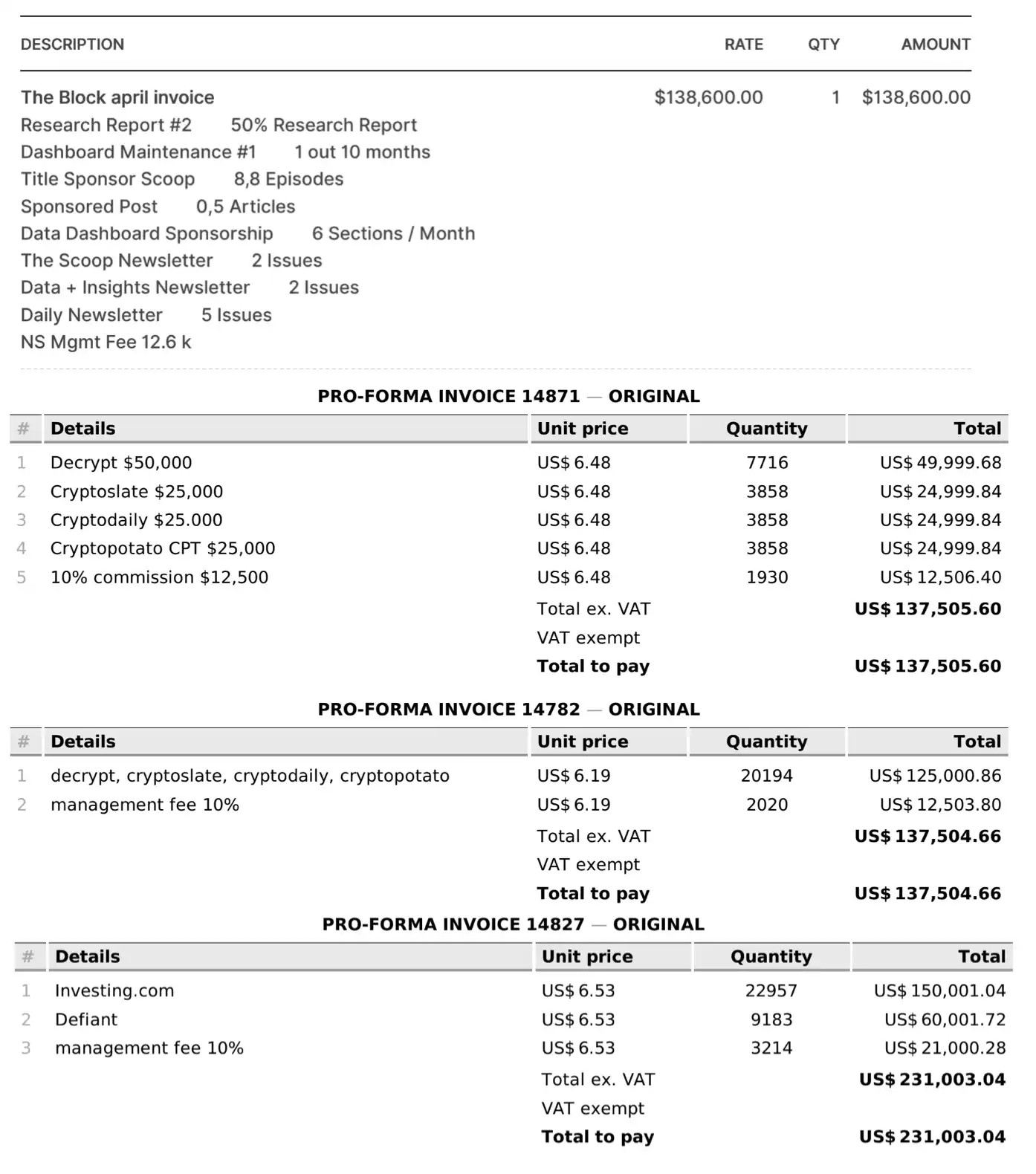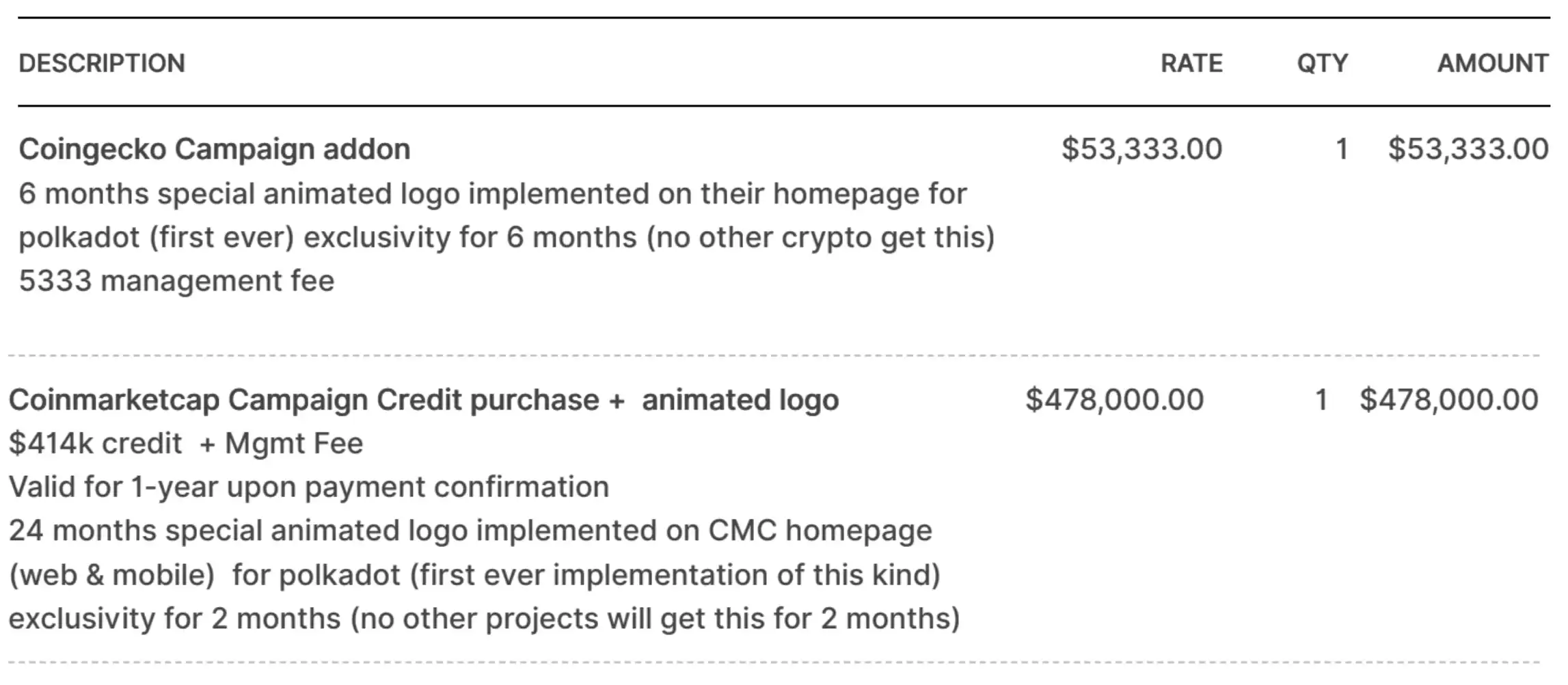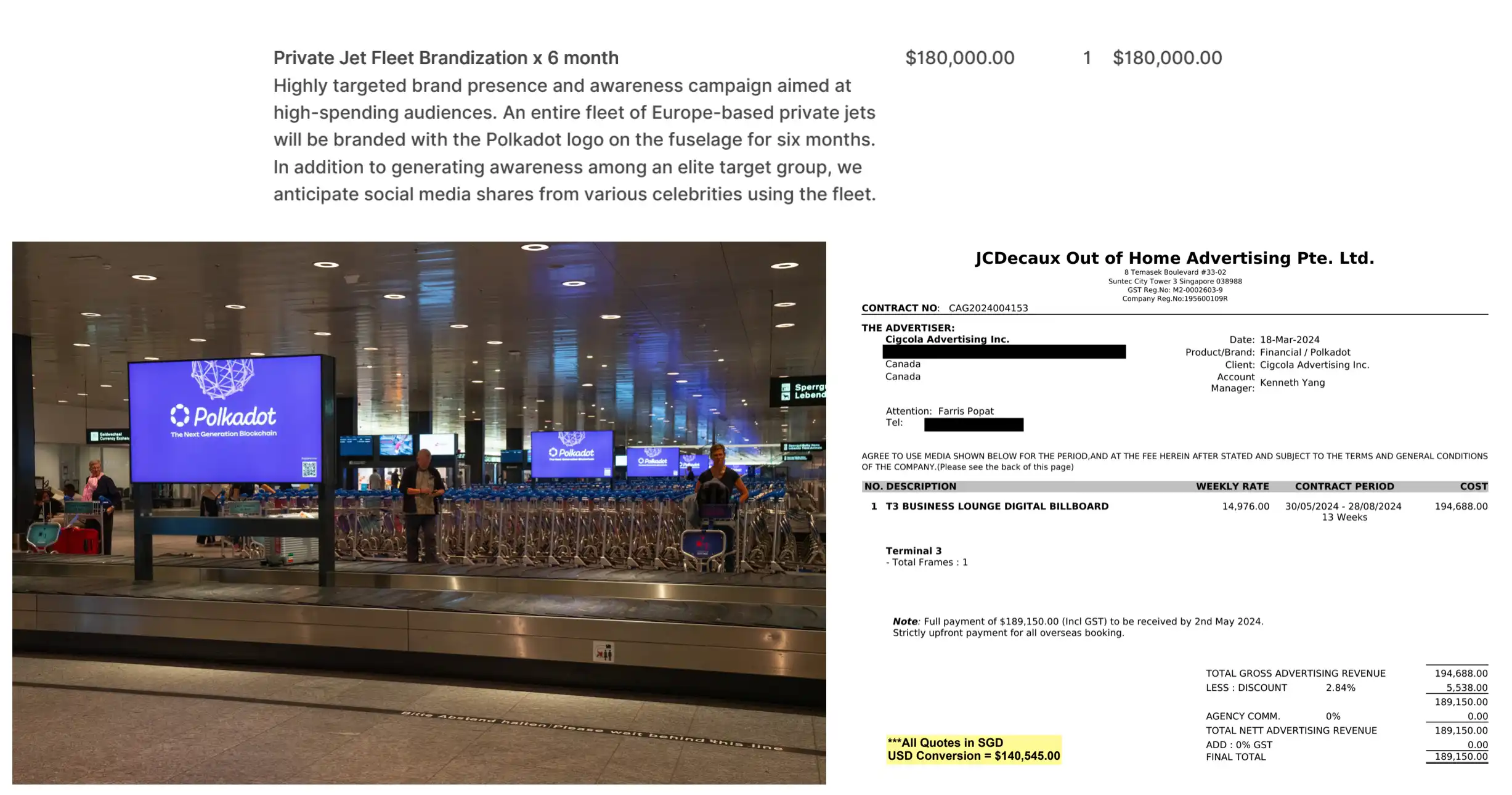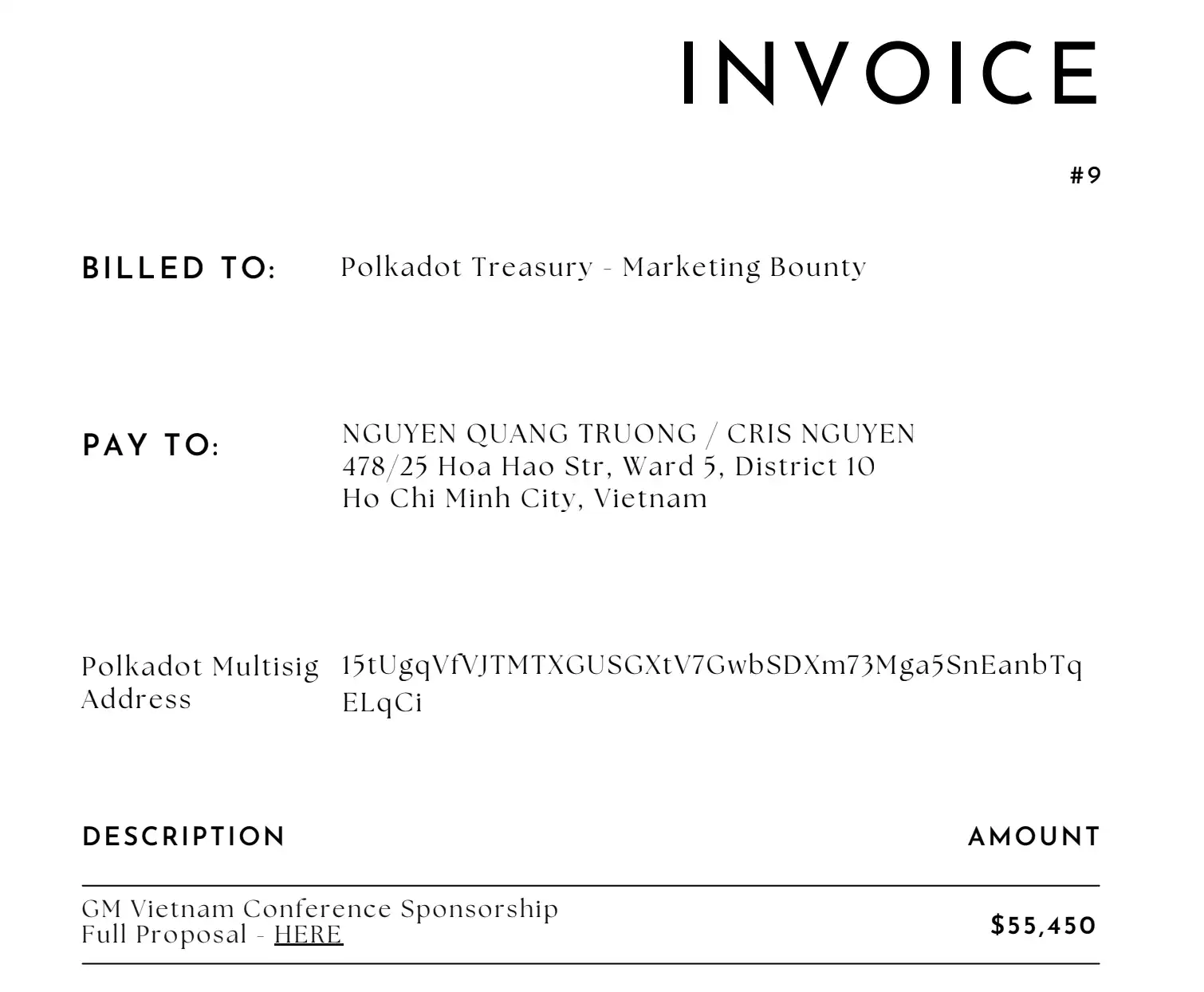On June 29, members of the Polkadot community released the Polkadot Treasury operations report for the first half of 2024. The Polkadot Treasury spent a total of US$87 million. If calculated based on the current spending rate, these reserves will only be enough for the Polkadot Treasury to last another two years.
To the surprise of the community, Polkadot spent $37 million on promotional expenses, accounting for the bulk of the treasury expenditure. Among them, advertising expenses cost $21 million, including $10 million in sponsorship fees, $4.9 million in marketing and public relations companies, and $4 million in digital advertising. Event expenses cost $7.9 million, including $4.5 million in event expenses, $3.9 million in business development, and $3.2 million in media production.
In response, BlockBeats found the relevant receipt documents for Polkadot’s marketing activities and sorted out its budget allocation for the first half of the year.
KOL marketing disasters: fake followers, fake content, and robot accounts
According to some statistics published on the Polkadot Market Bounty website , KOLs account for a large proportion of Polkadot’s marketing activities, exceeding half of the overall budget. Judging from the KPI data of content delivery, the effects of these KOL delivery activities seem to be good, with a total content view of more than 15 million times, a total of more than 570,000 likes, and a total of 60,000 replies.
In the first quarter, the KOL promotion activities of the Polkadot ecosystem included four Evox promotion activities for North America and three Lunar promotion activities for Europe. The average KOL budget for each promotion activity was about $300,000, and the duration was generally 30 days. The number of KOLs included in the Evox activity was about 30 to 40, while the number of KOLs in the Lunar activity was significantly less, about 15. There is also a community account Dot Army, with a single budget of $15,000.
However, after BlockBeats conducted an in-depth investigation into the actual quality of these content placements based on the KOL list, it was discovered that most of these so-called Content Creators were fleecing the users. Most KOLs took advantage of the situation in terms of the number of fans, promotional content, and reply content, and their fees were inflated.
For example, user X is a KOL with the handle @DeFiExpertise, who has only 25 followers, but his Youtube channel has over 70,000 subscribers. I clicked on it and found that he had posted less than 10 videos in total, and the account life span was less than 3 months. If we simply calculate based on the release time of the first video, the time when the channel was registered or became active was exactly when the current Evox event started.
The KOL with the handle @CriptoMindYT has 12,000 followers, but there is basically no overlap with the follower list of ordinary crypto Twitter users. Clicking on its follower list, it is found that most of them are robot accounts. In addition, this account is basically only a customized KOL for Polkadot, and almost only publishes content related to Polkadot. Except for a few retweets quoting Polkadot Army and Polkadot official Twitter content, most of the tweets have only about 200 views.
The KOL account @SharkyCoins has almost the same operation style and content as @ApeCryptos. It posts dozens of meaningless short sentences every day and retweets each other’s tweets, which makes people wonder whether these KOL accounts are from the same robot account studio. @MaxGanes also focuses on mass production of tweets. This account has posted more than 100,000 tweets in total, and produces nearly 20 illogical tweets with AI graphics every day.
Some other KOLs who focus on “eternal profit” will promote 20-50 targets at a time in each tweet. There are even many “one-time KOLs”, such as @DegenHardy, @TheCrypomist and other accounts that were still on the KOL list in April, but have been cancelled as of the time of writing, and accounts like @CryptoEmily have changed their names…
The DOT Army listed separately in the advertising budget is also very interesting. It includes an official community account and a service package of about 30 KOLs, with a single fee of $15,000 per month. Among them, the community account Dot Army often has tweets with extremely high reading volume, such as the tweet about DOT ETF on June 30, which has reached 110,000 readings. However, when clicking on the details page of the account, it is found that it has only about 200 fans. In connection with the above, it will be found that these tweets with high reading volume are the key forwarding targets of the list KOLs. Among the accounts in its KOL service package, more than 90% will show No one is following you among the people you follow.
In addition to crypto Twitter, Polkadot’s KOL promotion also focuses on Youtube channels, but many Youtube channel bloggers in the delivery scenarios often have misalignment with crypto users in terms of audience portrait. For example, the German Youtube blogger MilkRoad’s channel, which was launched in the first half of the year, mainly focused on general investment, which had little to do with the crypto industry, and most of the videos had only a few hundred views, while the content about Polkadot and DOT tokens was awkwardly inserted in the middle of these contents, with less than 500 video views in 4 months.
In May, the company chose to place its ads on the Marvel Snap gaming channel, which has nothing to do with cryptocurrencies. The explanation in the bill was precisely targeted high-net-worth audiences.
Surprisingly, Polkadot governance and the foundation do not seem to care much about the ineffective use of their KOL budget. After the KOL promotion activities in the first quarter, they even raised the KOL budget for the second quarter again. From May to June, the budget for a KOL promotion activity can reach 600,000 US dollars. However, it can be seen that the new promotion plan has submitted more detailed reports to the governance in terms of the specific traffic evaluation and requirements of KOLs.
In addition, it is not difficult to see that Polkadots KOL investment is basically aimed at the European and American markets, and they are all large-scale consumption, but there is basically no investment in the Asian market. BlockBeats reported in September last year that the Polkadot Chinese community PolkaWorld suspended operations for half a month due to the rejection of its application for official funding. Not long ago, Polkadot launched a new governance framework OpenGov, but PolkaWorld believes that the new treasury management mechanism has caused many long-term contributors and organizations to have their funding applications repeatedly rejected and forced to leave the Polkadot ecosystem. Now it seems that governance efficiency may be only one aspect of the problem.
Logo Fetish and Media VIP
In addition to KOL promotion, media placement and platform display also account for a high proportion of the budget, which is shown as PR and website Intergrations on the Market Bounty website. In addition, Boca seems to have some placement habits, giving out sky-high budgets in unexpected places, which makes people scratch their heads.
In the media PR placement, The Blocks extremely high fees first caught our eye. Several research reports and sponsored articles plus 1 dashboard maintenance cost $138,000, including a $12,000 management fee. Other crypto media such as Decrypt, Defiant, Cryptoslate, etc. are packaged as PR services, which are collected and executed by a governance entity called Community Project, and a 10% management fee is charged. The cost of each PR promotion is about $150,000.
Other PR promotions were directly allocated to the Community Project, but the specific requirements were clearly marked: arranging 75 articles and 18 content distributions through different channels, spending $100,000. There was also a Chainwire media PR fee of $150,000, but the service content was not specified.
In addition, Polkadot seems to have a special liking for logo display, and has spent money to purchase exclusive logo dynamic display services on two major crypto price websites, Coingecko and Coinmarketcap. Among them, the purchase of Coingeckos exclusive logo dynamic display for half a year cost $50,000, and the fee charged by Coinmarketcap is relatively higher, with two years of logo dynamic display plus management fees of nearly $480,000, and the average cost is twice that of Coingecko.
Although people did notice the change, it had little effect on increasing the appeal of DOT itself. Two months ago, someone asked on X, Why is it that only Polkadots token logo on Coinmarketcap has turned into a pink flame? The first reply in the comment section was, So what? Would you buy a coin for a GIF?
The logo display in the podcast video is also a big deal, with $110,000 spent on just eight episodes of content for the two podcasts.
In addition to these conventional channels, we also saw some puzzling placements in Polkadots budget bill. For example, through Future, a PR agency, Polkadot spent $20,000 to increase brand awareness on the PC hardware website Toms Hardware. 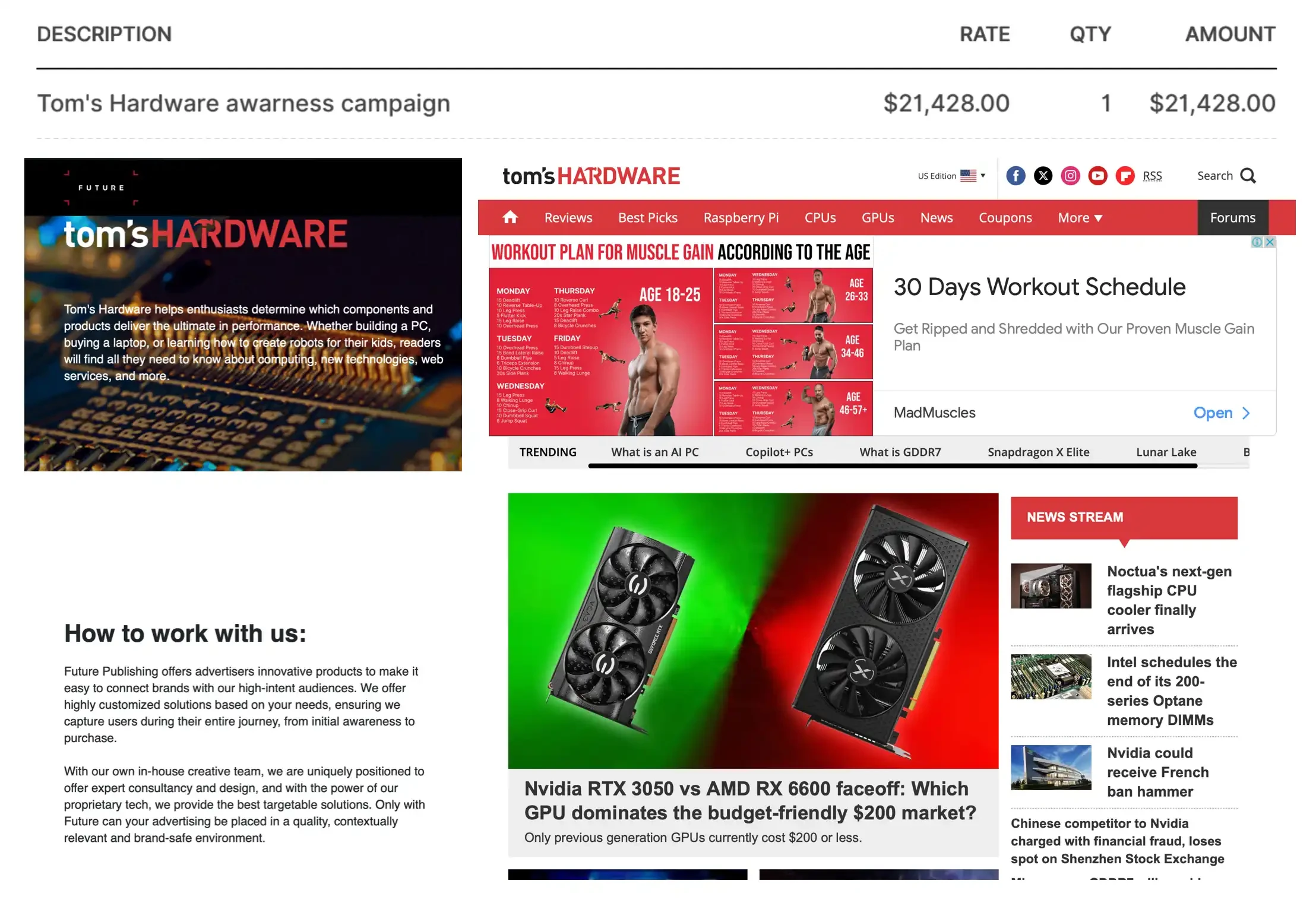
Another budget is to print the Boca logo on European private jets. This $180,000 promotional expenditure is planned to continuously display the logo on a fleet of European private jets for 6 months. The reason given is highly targeted brand promotion and awareness-raising activities for high-spending groups……
In comparison, the advertising screens at Singapore Airport and Zurich Airport seem relatively reliable, but the costs are still a bit too high. Just one advertising screen in one terminal of Singapore Airport cost $189,000.
This inflated quotation is also reflected in Polkadot’s event sponsorship fees. In the Vietnam Web3 event a few months ago, Polkadot spent $50,000 in sponsorship fees. In comparison, the platinum sponsorship during Ethereum Montenegro EDCON is about $50,000, and this $50,000 also allows you to have the opportunity to negotiate with Vitalik in the VIP room.
What is more interesting is that since Polkadot’s budget expenses are basically settled in DOT, but perhaps the recipients basically use US dollars to denominate, when the currency price fluctuates, there is often an item in Polkadot’s budget bill for “making up the difference”, and this difference is often $100,000.
Have you ever considered KOL business of inflating traffic and gaining popularity?
Is Polkadot really stupid? Anyone with a discerning eye can see the IQ tax, but Polkadot has repeatedly paid money with its eyes closed. Odaily mentioned in yesterdays 보고서 that the Polkadot community believes that Polkados greatest value lies in the treasury. In fact, the cryptocurrency circle is not lacking in expertise in project operations and marketing.
Regarding Polkadot’s sky-high budget, there is no shortage of claims in the community that “big players have emptied the treasury.” Although this has not been confirmed, there are indeed cases of arbitrage from the treasury by exploiting loopholes in the mechanism in decentralized governance projects and organizations. When Ludong was researching the Nouns community, it was learned that some community members had persuaded the DAO initiator and Nouns’ main holder to vote for their own promotion proposals, which were very expensive but actually had very low costs and benefits. In the case of RookDAO, the arbitrageurs directly controlled the protocol treasury by purchasing a large number of tokens, staging a “Baowan dispute” in the currency circle.
관련 자료:
1. All DAO organizations are either forking or on the road to forking
2. Rook quadrupled by dissolution. How did the DAO predator hunt for the DAO vault?
“KOLs may have secret agreements with foundations or team members. This actually happened in the last cycle,” an insider engaged in crypto marketing told BlockBeats. Although large projects like Polkadot usually adopt public governance, many small project foundations have only a few people in total, and many decisions are made directly by the CEO, which gives decision makers many opportunities to take advantage of.
However, in the case of Polkadot, it seems difficult for an individual to complete such a secret transaction because everything from proposals, voting to foundation payments is publicly visible. However, this does not prevent the community from being stupid in governance, because the current Twitter-centered marketing in the cryptocurrency circle is indeed full of IQ taxes and wool parties.
For example, the KOL account above has almost no flaws in terms of the number of followers, tweet readings, and interactions. If it weren’t for the loopholes in the follow list, it would be difficult for ordinary people to detect that this is a batch of fake accounts. “These accounts are generally written by studios and then swiped in batches, and the views, replies, and likes are very real,” a practitioner who previously worked in a KOL studio told BlockBeats. He said that now with AI tools, it is even more difficult to distinguish the authenticity and quality of KOL promotion content.
But in many cases, small projects choose to outsource to a studio out of helplessness. According to feedback from a practitioner with relevant experience, when small projects negotiate cooperation with top KOLs, either the KOLs look down on it and are unwilling to do it, or they offer a high price, making it difficult to reach an agreement. In addition, the message between KOLs is often transmitted very quickly. When the team negotiates with a KOL, other KOLs will soon know and immediately ask for the same price. However, if a TGE wants to be effective, it must have at least 100 to 150 KOLs. At this time, if the project does not have the strength, it is easy to fail in the negotiation, so it can only choose outsourcing as a second choice.
However, there are solutions. Jesse (@Jessethecook 69), who specializes in KOL promotion, told BlockBeats that many projects did not look for KOLs in the early stages, but focused on building a good community, and the final organic communication effect was also very good. In addition, you can also verify and supervise the studios promotion work through manual screening. The most effective way is to click on the KOLs follower list and comment area to see if it is mainly robots. Or just find a reputable and reliable organization, such as some mainstream media and top KOLs will have their own KOL matrix, they usually have a clear price and will not cheat you, said Jesse.
However, being able to identify fake accounts is one thing, and being willing to identify them is another. Insiders told BlockBeats that from KOL promotion to foundation market reports, there is a feedback mechanism that is responsible to the upper level. After receiving the task, the PR company or KOL studio needs to hand over a good promotion data report to the project party or the foundation, and the project party needs to prove to the VC that they are still working. This has led to the fact that whether the promotion is really effective is not truly included in the accountability system. In some cases, after the project foundation recruits the person in charge of the Asia-Pacific market, the person in charge will once again outsource the promotion work to the studio to make a fake report. Sometimes, the person in charge even finds a fake account to make a data report that is better looking and cheaper than the real one, so if the person in charge finds a KOL who is serious about promotion, he may have to explain to the foundation why the data is not as good as others.
Many project owners dont want to do anything, they just want to get money out of the treasury. I know some projects that didnt start looking for publicity and promotion until they were warned by the exchange to be delisted. But in this case, they dont really care about the actual benefits. After all, its a serious expense, and you cant check it even if its taken, a practitioner familiar with the situation told BlockBeats. In fact, in some cases, KOLs are just a tool for the team to empty the treasury. According to feedback from insiders, sometimes the indicators for arranging KOLs may come directly from investment VCs. Many times, exchanges, retail investors, and even fund LPs have been made suckers. Of course, LPs dont care about losing that little money.
Whether it is the super high FDV valuation of VCs or the sky-high promotion budget of project parties, many problems that have always existed in the crypto market have erupted one after another in the recent downward market environment. Jesse told BlockBeats that many times the responsibility does not lie with individuals, Not everyone wants to do evil, but the system is too stupid to give everyone the motivation to arbitrage. Obviously, the market is entering an adjustment cycle, which is not a bad thing. Without destruction, there is no construction. Perhaps squeezing the abscess is a necessary link before opening a new bull market.
This article is sourced from the internet: As much as 40 million US dollars, where did Polkadot’s promotion expenses go?
Original | Odaily Planet Daily Author | Asher Yesterday, due to the impact of the Mt.Gox incident, the market showed a clear selling sentiment, causing the BTC price to continue to fall, even falling below $58,500 in the short term. The price has rebounded. However, in this environment of BTC selling and mainstream currencies falling, the price of TON remained strong, vaguely showing that there was capital support. In the TON ecosystem, those who missed out on Notcoin should not miss Catizen, which currently has nearly 20 million registered users and plans to issue tokens in the second quarter. Next, Odaily Planet Daily will take you step by step to participate in the interaction of Catizen, a popular game in the TON ecosystem, and lock in potential token rewards. Catizen:…
